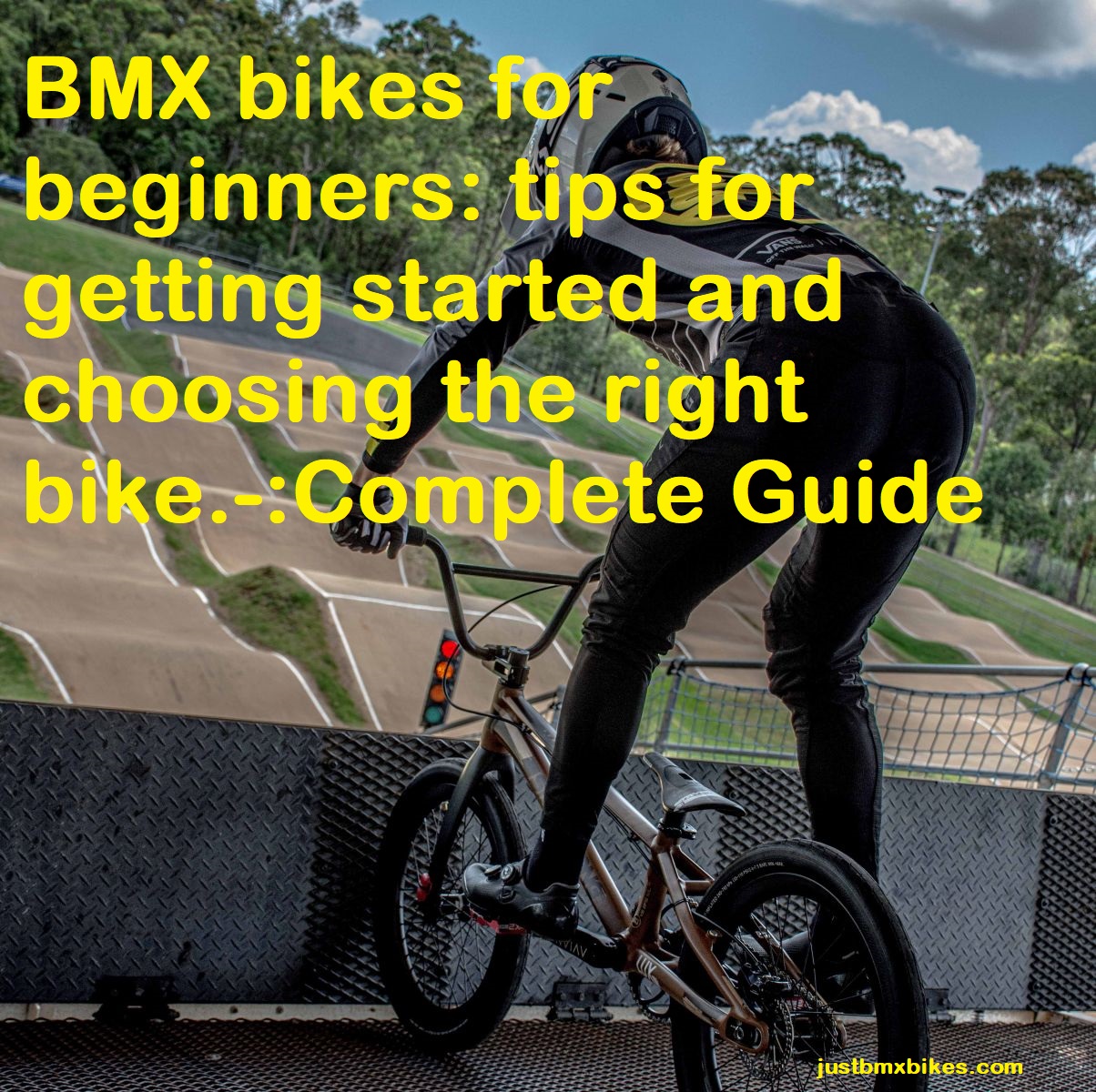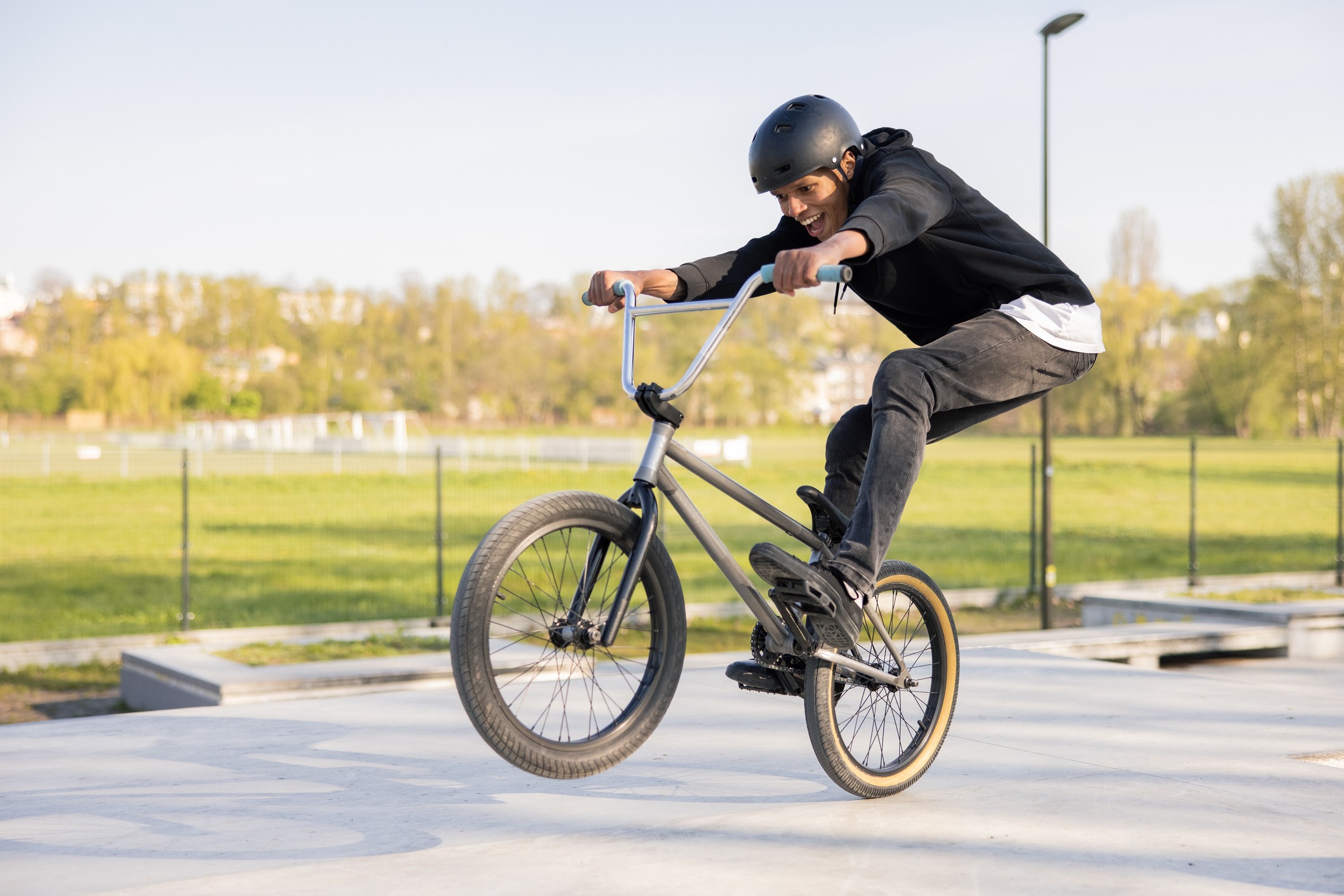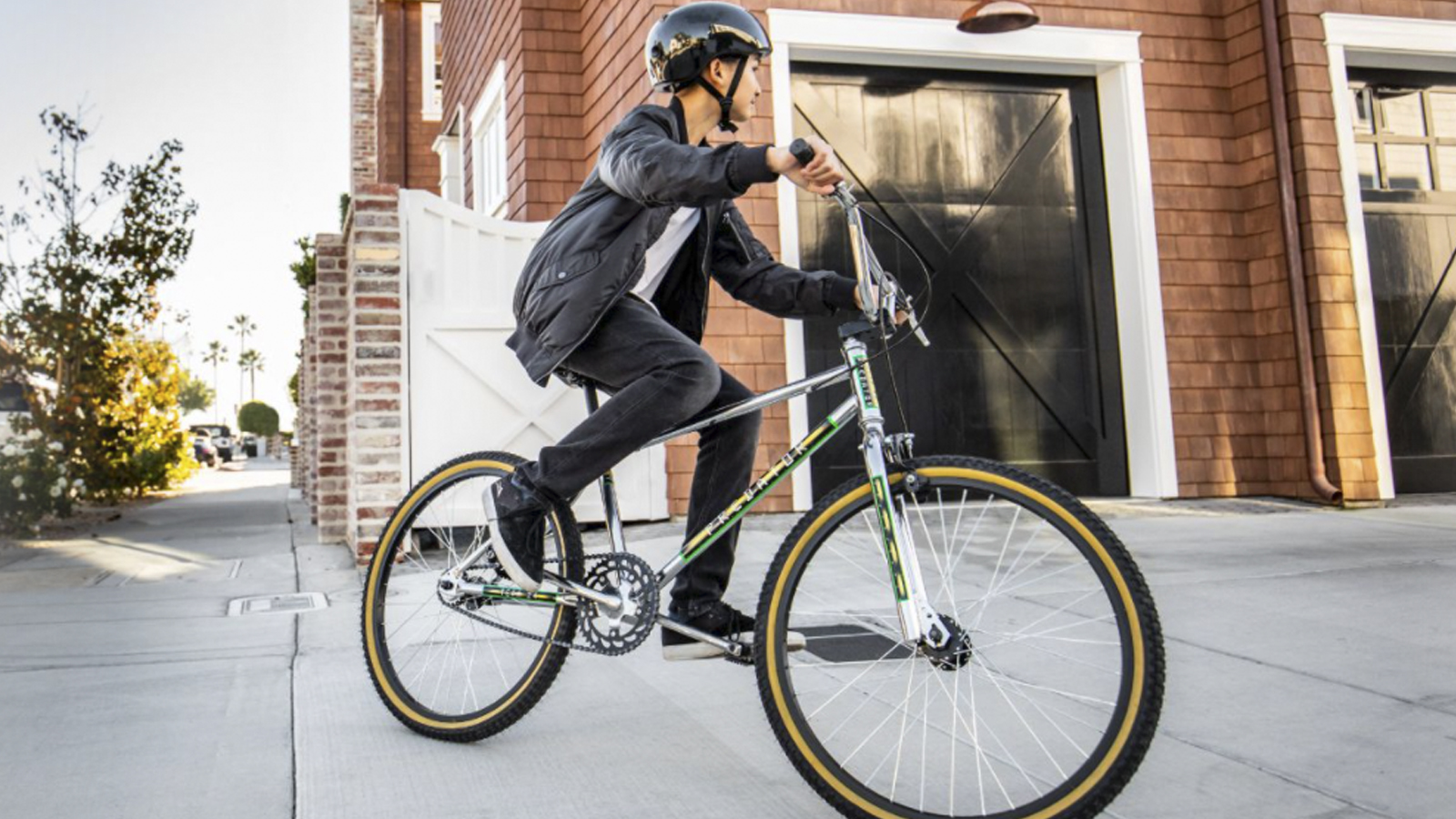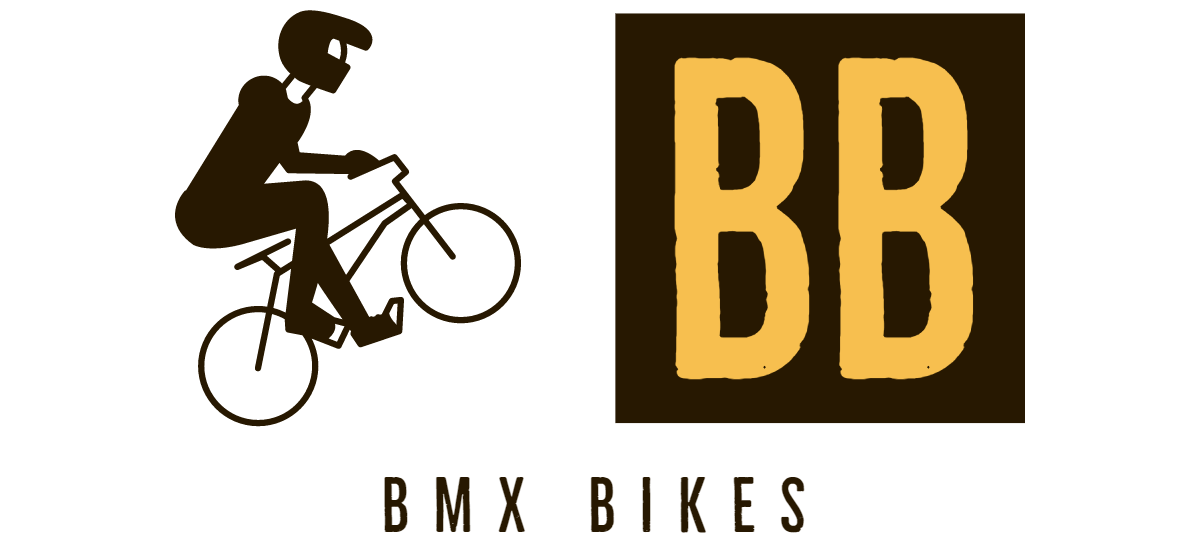Are you ready to take your cycling to the next level by becoming a BMX rider?
Taking on BMX as an activity or sport requires the right knowledge and gear. This guide will help you understand the basics of BMX biking, provide tips for getting started, and help you find the perfect bike to get going.
Welcome to the world of BMX biking! Whether you’ve been wanting to start for a while or you’re just beginning to explore this exhilarating sport, it’s important to have the right information to make smart decisions when you start. This guide will discuss different types of BMX bikes and some tips for getting started.
There are several essential things to know before making your first purchase. First, decide what type of bike you want—freestyle or race. Then consider which style is best for you—dirt jumping, park riding, flatland, street riding or slopestyle. There are variations within each style; each crossover defines its own unique purpose.
Next, determine the type of frame that best suits your needs and size—full chromoly (stronger and lighter) aluminum (lightest), steel (most affordable) or titanium frames may be available depending on what type of bike you choose.
Now consider components: brake types (rim vs disc brakes), wheel size/rim widths and options available in parts including handlebars, fork styles and headsets that can be added for customization purpose. It is essential to know about these features before buying them as not all parts are compatible with all types of bikes or frames.
Lastly but not least think about the cost involved in buying the bike as they can range from a few hundred dollars up into thousands depending on model/style selected.

Definition of BMX biking
BMX stands for bicycle motocross, which is a sport that involves cycling off-road and over jumps using bicycles designed for the terrain. It’s a fun, thrilling way to stay active and the levels of skill required range from beginner to expert. BMX bikes come in all sizes for different types of riders. If you’re new to BMX biking or want to upgrade your current bike, it’s important to understand what type of bike you need.
The main components of BMX bikes are the frame, fork, crankset, tires, handlebars and pedals. Each part contributes to the overall functionality and performance of your bike. The frame is one of the most important parts because it impacts handling, stiffness and overall aesthetics. The size and shape will determine how well your bike performs on different terrains. Additionally, it’s important to check that the frame matches up with other components such as cranksets in order to get the best performance out of your machine.
When picking out a fork for your ride be sure it lines up correctly with front wheel axles as there are countless options available for varying terrain use. Different types include rigid forks (which provide stability mainly on flatland) steel forks (made from high grade 4130 chromoly tubing), suspension forks (for when looking for more control over rougher terrain).
It is also equally important that you choose tires appropriate for the level rider you are and desired riding surface – more aggressive riders tend towards knobbier treads while smoother terrain can be ridden easily with semi-slick or slick treads depending on desired speed/drift capabilities in dirt parks respectively. It is worth taking some time considering these aspects when wanting optimum performance in order get better value out of this investment too since cost-effective gearing can add extra life span/mileage too! Lastly don’t forget about brakes whose type depend greatly upon riding style – v-brakes stand popular due their reliable stopping power while disk brakes offer superior modulation/potency at costs one must weigh carefully!
Importance of choosing the right BMX bike for beginners
Choosing the right BMX bike is an essential part of getting started in the sport. Having a bike that fits your size and abilities can make a huge difference in how much you enjoy riding.
BMX bikes come in all sizes, from extra-small for children and young adults to pro-level race bikes for experienced adults. It’s important to choose the right size for your height and riding style — a frame that’s too tall can cause balance issues, while one that’s too small can create safety concerns. Additionally, choosing a good quality bike with features designed to suit your goals will help you get the most out of riding.
For beginner riders, there are several key factors to consider when selecting a BMX bike: price, weight, component quality and style (race or freestyle). Price should be based on what fits in your budget — most entry-level models start at around $300–$400 — while freestyle models cost more due to upgraded components and features designed specifically for tricks and stunts. The weight of the bike will affect how it rides and handles; lighter bikes accelerate faster but may not last as long as heavier models. High-quality components provide better braking performance, smoother power transfer when pedaling hard, and longer wheel lifespan than standard components. Finally, if your goal is competitive racing you will likely want to choose a race-specific model; on the other hand if you plan on doing jumps or tricks you’ll probably want to opt for a freestyle frame optimized for those types of activities.
Once you have determined which size bike is best for you based on fitment guidelines outlined by manufacturers or experienced technicians at local shops, it’s time to assess component quality before officially committing to the purchase. Researching what makes up high performing parts versus standards ones helps determine which model will provide years of safe rides instead of failing shortly after buying it due to inferior product composition.
Understanding BMX Bikes
BMX bikes come in all shapes and sizes, but all share the same fundamental characteristics. Let’s take a closer look at BMX bike anatomy and understand what distinguishes them from other bike types.
Frame:The BMX frame is the backbone of the bike, the part to which all the other components attach. It is typically made of light yet tough chromoly steel that flexes slightly when you land jumps and tricks, giving smooth ride feel. The right frame size is critical; too short or tall of a frame can cause loss of control while riding.
Tires: BMX bikes have knobby 20” tires that offer excellent grip when turning sharply and tackling jumps. For most riding disciplines, tires in the 1.9-2.25” width range work best, although larger tires may be used for dirt riding or off-road terrain because they provide added cushioning for jumps and drops. Tread patterns also vary among tire types — for example street riders often choose low tread designs for smoother rolling on urban surfaces like concrete, whereas dirt jump riders opt for large aggressive knobs to offer superior grip when cornering or in wet conditions.
Brakes:All modern BMX bikes have some sort of braking system — either caliper brakes (typically found on entry-level freestyle bikes) or disc brakes (the preferred choice for more experienced BMXers). Caliper brakes are mounted directly onto the front fork post with two short arms that squeeze together — good stopping power but limited adjustability compared to disc brakes which require a rotor attached to the hub center instead of directly onto the fork post; they offer superior performance under extreme braking force as well as more options like how many fingers one applies on each side etc., making it easier to customize your ride feel according to your preference.
Parts of a BMX bike
Learning about the parts of a BMX bike can be helpful when you’re trying to decide which model best fits your needs. Some of the major components which make up a BMX bike include the frame, fork, handlebars, headset, stem, bottom bracket and cranks.
The frame is without a doubt the most important part as it’s what connects all other components and also forms the shape and size of your bike. A quality frame should be strong and lightweight to give you an efficient ride and powerful air tricks at higher speeds. The two types of frames available in BMX bikes are freestyle frames and race frames.
The fork holds the front wheel in place and like any quality bike fork it should be structurally sound but light enough to handle great tricks with ease. Keep in mind that most BMX bikes have suspension forks which provide additional comfort while taking jumps or performing stunts out on the track or park.
The handlebars allow you to control your direction while riding so getting a pair of good ones is essential when looking for a good BMX bike. Standard size bars not only ensure you’re comfortable while riding but they also provide strength during your crashes or when pulling off combos with ease at higher speeds.
A headset is used on all types of bicycles including BMX bikes which allows for tilt adjustment on your handlebars as it moves up and down from the main BMX frame tube but won’t rotate side-to-side if well-fitted into its space with protective rubber pads after installation for added support if needed during intense rides.
The bottom bracket houses your crank arm axle inside casing usually made from aluminum alloy for maximum strength & endurance plus more weight savings that can help during jumps & stunts performed by riders going beyond limits every time they use their machines out on tracks around town or parks nearby cities nationwide!
Lastly, the crankset (with pedal attachments) offers riders easy maneuverability while they gain speed & power by spinning chains connected directly onto their rear wheel each time they go down hills.
Factors to consider when choosing a BMX bike
When buying a BMX bike, there are several factors to consider. The most important of these is the size, which will vary based on the type of BMX you are looking for. They range from Small (up to 20″) and Medium (20″ – 24″) sizes, to Large (24″-26″) and XL (26″ upwards) sizes. It’s important that the bike fits correctly, so it pays to measure up carefully!
Next, look at how much travel you need the bike suspension to offer. Suspension is particularly useful in BMX and can be adjusted according to your weight and experience level, so it’s worth a deeper look.
The gear ratio is also important when deciding which type of riding you need your bike for. For example, if you’re looking for speed then higher gear ratios (over 3:1) will work better than lower ratios (under 2:1). However low gear ratios are better suited for technical dirt jumping or freestyle riding.
Lastly look at the frame materials available. Steel frames offer strength and durability but tend to be heavy; aluminum frames are lightweight but less durable; chromoly steel is strong and relatively lightweight – a great all round choice; carbon fiber offers the best combination of weight and stiffness but can be expensive. With some basic background knowledge in hand, find a reputable dealer who specializes in BMX bikes and go from there!

III. Maintenance and Care
Regular maintenance and repairs will ensure your bike works properly, but will also maximize the lifetime of your bike. Taking care of the most important components, like wheels, gears and brakes, is essential for a smooth ride.
Wheels: The key elements in maintaining a smooth rolling wheel are to ensure it is always inflated to the proper psi range and that there is no debris lodged between spokes or elsewhere on the rims. Inspect for wear on tires regularly as well as excess dirt build up that can interfere with brake pads.
Gears: Check gears regularly to ensure they move smoothly when you shift them. If they feel rough or jumpy when shifting, tighten the limit screws and adjust any indexing issues by aligning correctly in the large gear cog on your cassette hub. Also, inspect cassette cogs for wear – eventually these will need to be replaced due to common wear and tear over time.
Brakes: Confirm brake pads are secure and have proper tension – there should be slight tension when squeezing either rotor or caliper/U-brake levers which indicate adequate brakes system performance. If necessary, apply light lubricant water-repellent grease (lithium-based) where indicated in brakes instructions for maximum efficiency during use of manual or hydraulic disc brakes. Additionally, choose fitted-components specifically suited – rim versus disc – for whatever application at the time like street riding or trails riding.
Importance of maintaining a BMX bike
Maintaining a BMX bike correctly and regularly is essential for ensuring that it is running safely, efficiently and at its best performance. It also extends the life of your bike and will save you money by not having to replace components or even the entire bike. Depending on how often you ride, it’s important to check up on your bike once a month, ensuring all components are tightened, adjusted and lubricated as needed. Ensuring gears are shifting smoothly, tires have enough air pressure for best contact patch with the ground and brakes are properly set up can help increase performance.
It’s recommended to clean your BMX frame after each ride to prevent corrosion or damage due to dirt build-up. Also be sure to check any parts that may work loose over time such as handlebars/stems, seatposts etc., so they remain tight–this will also help prevent any damage caused by vibrations while riding. Depending on riding location – street/skatepark/dirt etc., checking fork seals & oiling them may be necessary if stanchions (the part of the fork that slides when extending / compressing) start showing signs of dryness or not reacting like how they used to once upon time.
BMX bikes use metal parts for most operating mechanisms like bearings which should always have enough grease applied when in use or stored during winter periods; this helps with efficiency & reduces wear of these parts over time thereby increasing their working life span. Another important factor that many overlook would be keeping spokes properly tensioned in order for wheels & rims (tires) stay firmly attached regardless of shooting down jumps or grinding rails! Be sure when doing maintenance activities on any part of your bike that manufacturer recommendations and steps should be followed – it’s important!
Tips for maintaining a BMX bike
Maintaining your BMX bike is key in ensuring its longevity and performance capability. Proper maintenance will also decrease frequent repairs and replacements, saving you time and money. Here are some tips for maintaining your BMX bike:
- Regularly check for rust and signs of wear on your frame, wheels, and other components.
- Oil any moving parts regularly to keep things working smoothly and prevent further rusting or damage.
- Store your bike indoors or at least in a covered area when not in use to protect it from the elements.
- When riding off-road, always wear suitable safety equipment such as gloves, a helmet, elbow pads, knee pads and proper footwear.
- Get into the habit of keeping all of the nuts and bolts properly tightened after every ride to ensure that there are no rattling sounds coming from your bike when riding or when left unattended outdoors.
- Brake pads should be checked for excessive wear once a week depending on how frequently your ride.
- Your tire pressure should be maintained responsibly for maximum performance; higher pressure is generally better suited for road Riding while lower pressure is ideal for trail/off-road riding.
- Remain vigilant on trails – make sure to avoid obstacles that might hinder the performance of your machine or cause accidents.
How to clean and store a BMX bike
Once you have taken the time to select the right BMX bike, it’s important that you look after it properly so that it will last for years. Regular care and maintenance can help ensure that your bike is safe to ride and looks great on the track.
Cleaning: Cleaning your bike regularly is an important part of maintaining it. Use a cloth or brush to remove dirt and debris from any components that are not covered by plastic covers. Make sure to check all nuts and bolts, as these can become loose over time.
Lubrication: Once cleaned, ensure subjected components such as chains and cables are properly lubricated in order to keep them running smoothly. Lubricate all moving parts in order to prevent rusting and premature wear-and-tear of parts caused by friction and poor maintenance.
Storage: When storing your bike, try to keep it away from direct sunlight, moisture, chemicals or any other elements which could damage its components or paintwork. Cover the bike with a sheet or cloth when extra protection is needed, especially in hot climates where excessive heat could affect plastic parts such as grips, tyres etc.. Always remember to safety check your equipment before riding even after a period of storage.
It’s also important that you stick to the manufacturer’s recommendations when adjusting gears or doing other maintenance tasks on your bike as incorrect adjustment can lead to damage and/or injury – always refer to an official manual when attempting repairs yourself!

Conclusion
Overall, getting started in BMX biking is an exciting journey and a great way to get outside and have some fun. When selecting the right bike for you, be sure to consider the factors that are important – such as size, style of riding, terrain type and cost.
Be sure to take your time selecting the best bike that meets your goals and needs so you can enjoy a safe, comfortable and successful ride every time. With proper preparation and research, you’re sure to find the perfect BMX bike to help get you on your adventure.
FAQ’s
What should I learn first on BMX?
You should learn the basic techniques of balancing, pedaling, turning, and stopping on a BMX bike.
What kind of BMX bike should I get?
It depends on your riding style and budget. For beginners, a decent quality entry-level BMX bike with a 20-inch top tube length is a good choice.
What is the best BMX race bike for beginners?
The best BMX race bike for beginners is the one that fits you well and suits your riding style. Look for a lightweight and sturdy bike with good components.
How do I choose the right size BMX?
The right size BMX depends on your height and riding style. A general rule is that the top tube length should be around 20 inches for most riders.
What are the basic skills for BMX?
The basic skills for BMX include balancing, pedaling, turning, jumping, pumping, and landing.
How do I start learning BMX?
Start by practicing the basic skills in a safe and controlled environment, such as a skatepark or a BMX track. Take lessons from a qualified instructor if possible.
When should I start BMX?
You can start BMX at any age, but it’s easier to learn at a younger age when you have more time and energy to devote to it.
Are BMX bikes hard to ride?
BMX bikes can be challenging to ride at first, but with practice and perseverance, you can master the basic skills and enjoy the ride.
Is A BMX a good first bike?
Yes, BMX bikes are a good first bike for many riders, especially those interested in freestyle or racing.
Is 21 too old to start BMX?
No, 21 is not too old to start BMX. You can start at any age and progress at your own pace.
See more-
- Best bmx bikes for adults 2023
- Best bmx bikes for beginners 2023
- Best bmx bikes for dirt jumping 2023
- Best bmx bikes for kids 2023
- Best bmx bikes for racing 2023

